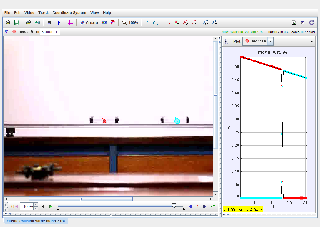

About
For Teachers
- elastic collision same mass 2.mp4
Credits
Author: Leong Tze Kwang, Lim Beng Choo
Document Brief: Title: "Tracker 2/5 Elastic Collision with Same Masses by Leongster"
This document explores a 2/5 elastic collision scenario where two objects of equal masses interact. The focus is on momentum conservation, energy distribution, and the implications of partially elastic collisions with a coefficient of restitution of 0.4.
Study Guide:
Objective: Investigate the dynamics of a 2/5 elastic collision involving two objects of equal masses, emphasizing momentum conservation and partial energy retention.
Key Concepts:
-
Elastic Collisions:
-
Collisions characterized by partial energy conservation, defined by the coefficient of restitution .
-
-
Conservation of Momentum:
-
The total momentum before and after the collision remains constant: , where is the equal mass of both objects.
-
-
Energy Distribution:
-
A portion of the kinetic energy remains in the system, with some converted to heat, sound, or deformation.
-
-
Coefficient of Restitution (e):
-
Defined as , indicating the ratio of relative velocities before and after the collision.
-
Experiment Overview:
-
Setup: Two objects of identical mass collide on a frictionless surface. Their motion is analyzed using video tracking software such as Tracker.
-
Procedure:
-
Record initial and final velocities of both objects.
-
Verify conservation of momentum and calculate the coefficient of restitution.
-
Determine the percentage of kinetic energy retained post-collision.
-
-
Observation Points:
-
Changes in velocity due to collision.
-
Energy lost as a fraction of initial kinetic energy.
-
Questions to Consider:
-
Why do objects of the same mass exchange velocities in elastic collisions? (Ideal case )
-
Answer: Due to symmetry and conservation laws; however, with , velocities are only partially exchanged.
-
-
How is energy retention calculated?
-
Answer: By comparing initial and final kinetic energy: .
-
-
What role does the coefficient of restitution play?
-
Answer: It determines the elasticity of the collision, affecting the post-collision velocities and energy distribution.
-
Applications:
-
Understanding energy dynamics in sports collisions, such as billiards.
-
Exploring material properties affecting elasticity.
-
Demonstrating momentum conservation in classroom experiments.
FAQ:
-
What is a 2/5 elastic collision? A collision where the coefficient of restitution is 0.4, meaning 40% of the relative velocity is retained post-collision.
-
Why use objects of equal mass? To simplify calculations and highlight the effects of elasticity on collision dynamics.
-
How does the coefficient of restitution affect energy loss? A lower value indicates greater energy loss, with more energy converted to non-kinetic forms.
-
Is momentum always conserved? Yes, momentum conservation holds regardless of the collision's elasticity.
-
What practical insights does this study provide? It aids in designing systems requiring controlled energy dissipation, like crash barriers or sports equipment.
- Details
- Written by leongster
- Parent Category: 03 Motion & Forces
- Category: 02 Dynamics
- Hits: 5625
